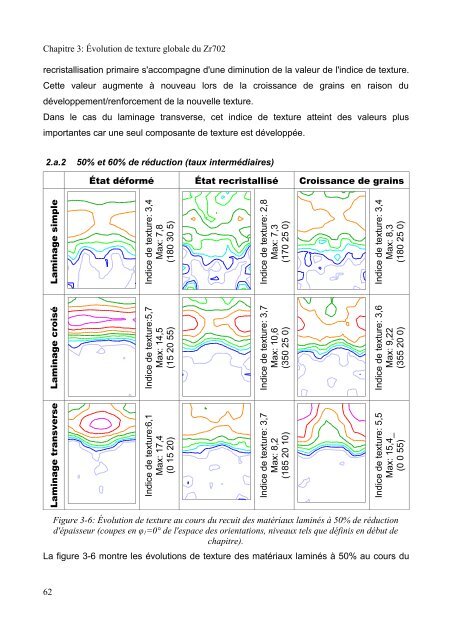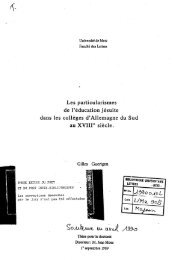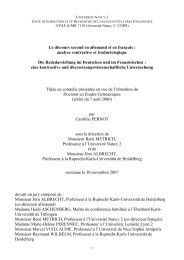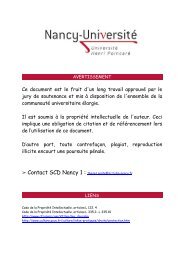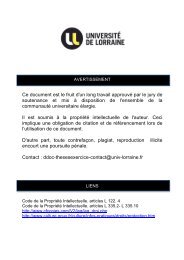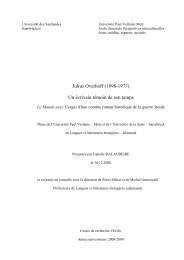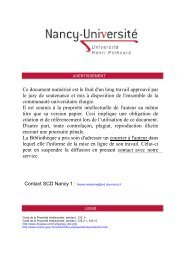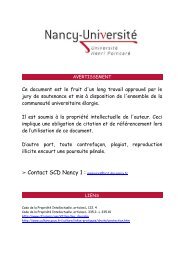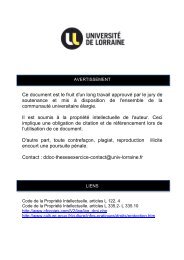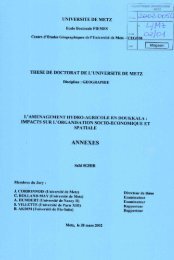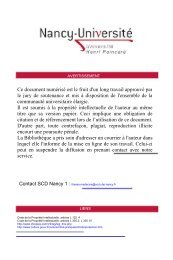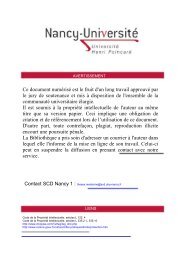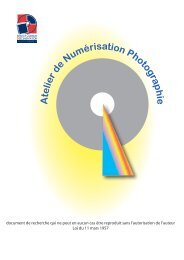Mécanismes d'évolution de texture au cours du recuit d'alliages de ...
Mécanismes d'évolution de texture au cours du recuit d'alliages de ...
Mécanismes d'évolution de texture au cours du recuit d'alliages de ...
You also want an ePaper? Increase the reach of your titles
YUMPU automatically turns print PDFs into web optimized ePapers that Google loves.
Chapitre 3: Évolution <strong>de</strong> <strong>texture</strong> globale <strong>du</strong> Zr702<br />
recristallisation primaire s'accompagne d'une diminution <strong>de</strong> la valeur <strong>de</strong> l'indice <strong>de</strong> <strong>texture</strong>.<br />
Cette valeur <strong>au</strong>gmente à nouve<strong>au</strong> lors <strong>de</strong> la croissance <strong>de</strong> grains en raison <strong>du</strong><br />
développement/renforcement <strong>de</strong> la nouvelle <strong>texture</strong>.<br />
Dans le cas <strong>du</strong> laminage transverse, cet indice <strong>de</strong> <strong>texture</strong> atteint <strong>de</strong>s valeurs plus<br />
importantes car une seul composante <strong>de</strong> <strong>texture</strong> est développée.<br />
2.a.2 50% et 60% <strong>de</strong> ré<strong>du</strong>ction (t<strong>au</strong>x intermédiaires)<br />
Laminage simple<br />
Laminage croisé<br />
Laminage transverse<br />
État déformé État recristallisé Croissance <strong>de</strong> grains<br />
Indice <strong>de</strong> <strong>texture</strong>: 3,4<br />
Max: 7,8<br />
(180 30 5)<br />
Indice <strong>de</strong> <strong>texture</strong>:5,7<br />
Max: 14,5<br />
(15 20 55)<br />
Indice <strong>de</strong> <strong>texture</strong>:6,1<br />
Max: 17,4<br />
(0 15 20)<br />
Indice <strong>de</strong> <strong>texture</strong>: 2,8<br />
Max: 7,3<br />
(170 25 0)<br />
Indice <strong>de</strong> <strong>texture</strong>: 3,7<br />
Max: 10,6<br />
(350 25 0)<br />
Indice <strong>de</strong> <strong>texture</strong>: 3,7<br />
Max: 8,2<br />
(185 20 10)<br />
Indice <strong>de</strong> <strong>texture</strong>: 3,4<br />
Max: 8,3<br />
(180 25 0)<br />
Indice <strong>de</strong> <strong>texture</strong>: 3,6<br />
Max: 9,22<br />
(355 20 0)<br />
Indice <strong>de</strong> <strong>texture</strong>: 5,5<br />
Max: 15,4_<br />
(0 0 55)<br />
Figure 3-6: Évolution <strong>de</strong> <strong>texture</strong> <strong>au</strong> <strong>cours</strong> <strong>du</strong> <strong>recuit</strong> <strong>de</strong>s matéri<strong>au</strong>x laminés à 50% <strong>de</strong> ré<strong>du</strong>ction<br />
d'épaisseur (coupes en φ1=0° <strong>de</strong> l'espace <strong>de</strong>s orientations, nive<strong>au</strong>x tels que définis en début <strong>de</strong><br />
chapitre).<br />
La figure 3-6 montre les évolutions <strong>de</strong> <strong>texture</strong> <strong>de</strong>s matéri<strong>au</strong>x laminés à 50% <strong>au</strong> <strong>cours</strong> <strong>du</strong><br />
62<br />
Constant Phi1 = 0 Constant Phi1 = 0<br />
Constant Phi1 = 0 Constant Phi1 = 0<br />
Constant Phi1 = 0<br />
Constant Phi1 = 0 Constant Phi1 = 0 Constant Phi1 = 0<br />
Constant Phi1 = 0


